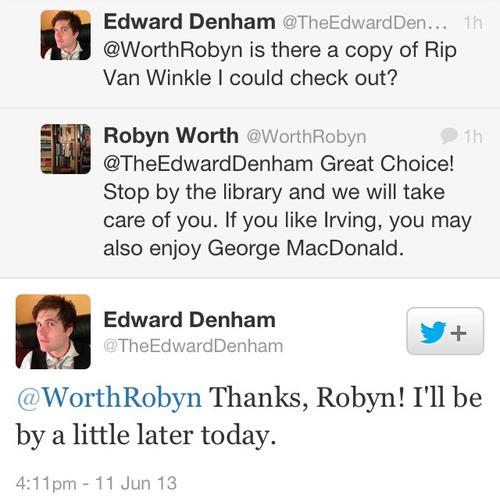Jay Bushman is an Emmy-winning transmedia producer, show runner and writer. He was behind the Jane Austen inspired, tremendously successful, 153 episode series
The Lizzie Bennet Diaries and more recently, its 27 episode summer spinoff
Welcome To Sanditon. An innovator in the way we experience narrative entertainment, Bushman is the co-founder and leader of the group Transmedia Los Angeles, the creator of the Fourth Wall Studio series
Dirty Work, and the genre-defying, animated steampunk show
Airship Dracula. He’s comfortable telling stories that cross platforms in unexpected ways: Viewers of his work may jump from YouTube to Twitter, to LinkedIn, to Facebook, Tumblr, OkCupid and more over the course of one character’s brief conversation with another.

Recently, Bushman sat down with Dice News to talk about what it’s like to tell a complex, multi-character story across platforms, and why Twitter may be the way to a viewer’s heart.
The Lizzie Bennet Diaries seemed to come out of nowhere and then it was everywhere. How did that happen? The video part of it was the easiest from a time-management standpoint. We shot one day a month and eight or nine episodes in a day. We had one really long day to create enough content to release episodes twice a week, and then each spinoff had its own day of production as well. At its height we did five or six episodes per week but that doesn’t count all the other platforms we used. YouTube was the core but Twitter was our main platform. I love Twitter and spent a lot of time using it as a story-telling device. Also I think it’s the platform with the most penetration among the audience and the one that most of the other platforms feed into. It’s not about the individual tweet -- it’s about a series of tweets and what happens in between them. It’s much easier to tell a story using multiple voices on Twitter, too.

We used Facebook as well but it’s not flexible enough for the storytelling we want to do. We also used Tumblr and some LinkedIn. We also used a site called This is My Jam, which allows you to tune into music you like. We experimented with Get Glue and Pinterest. I’m sure I’m forgetting some. There were so many. We’d have an idea and say, “Let’s see if this platform will work” and then go try it. If it worked really well it became part of the story. This is My Jam is a good example of that. LinkedIn is an example of us trying something that was OK for what it was but not a platform we’d use again. We had an OKCupid site that was a lot of fun but not many people found it.
What programs do you use to connect the platforms? We use completely off-the-shelf services. We do no programming of our own. That’s actually a really important element of how I believe transmedia should work. To me, it’s a democratizing format that anybody who has access to the Web and web services should be able to use to tell stories. It should be really inexpensive if not free.
Storify was the big tool in our tool belts. We have a main website for
Lizzie Bennet Diaries that has a running list of links. When you tell a story over a year that is constantly updating, you have to find a way for people who discover it mid-way to catch up. Traditionally this has been something that transmedia has been really bad at. We have a story page that includes a list of links. When there are important social media interchanges we aggregate them, mostly on Storify. If you wanted to see
Lizzie Bennett now, even though it’s over, you could go to that page and get nearly the entire story.

You worked with the (storytelling platform) Theatrics to cross platform Welcome to Sanditon. Were you part of the conversation as to how to set up the program? No programming was done at all for either Storify or Theatrics, although maybe there was a little HTML for the websites but that’s about it. Theatrics allows you to record video and aggregate it in a single place and make it look like it’s part of a specific story. It’s the perfect tool for the job. They’ve been really helpful in taking their site and skinning it so it looks like it’s in the world of our story. It lives at
domino.pemberlydigital.com so it extends the illusion that you are part of the story. It’s been fantastic.
Did Theatrics have any input for Sanditon’s Domino App? It seemed nearly real enough to work. Domino is a fictional app. It’s a tool we used to overcome some of the limitations of login style storytelling. If it were real, it would be able to do things that are really scary. We have a running joke that sort of implies that Domino has some kind of artificial intelligence built into it. The AI that runs Domino really, really likes romance. We introduced the Alpha of the Domino app in the Gigi Darcy spinoff [
Welcome to Sandition] and it was wildly popular. We got a completely different audience of tech people from around the world who thought it was real. When we came up with
Welcome to Sanditon as a shorter summer series, we wrote the Domino Beta test into the story.
Do you foresee bringing programmers in house to create elements of the story instead of going outside to Storify or Theatrics? That would be a secondary concern. We’re primarily a story-telling company and so if we need something to tell the story, then we need something to tell the story. Given that our production margins are so small, spending money on development of an app isn’t high up on our food chain, but who knows? Things may change but it’s really not my place to say.
Have fans ever offered to jump in with their technical knowhow? We have had a couple but nobody has actually volunteered to code an app for us. I have some specific, personal thoughts about a direction to take an app that’s separate from these stories, but can‘t get into it right now. That being said, I haven’t had any fans who are coders or developers who have offered to build something on that scale. We have a lot of artists who make incredible artwork and fan fiction, but not a lot of coders.
 Recently, Bushman sat down with Dice News to talk about what it’s like to tell a complex, multi-character story across platforms, and why Twitter may be the way to a viewer’s heart. The Lizzie Bennet Diaries seemed to come out of nowhere and then it was everywhere. How did that happen? The video part of it was the easiest from a time-management standpoint. We shot one day a month and eight or nine episodes in a day. We had one really long day to create enough content to release episodes twice a week, and then each spinoff had its own day of production as well. At its height we did five or six episodes per week but that doesn’t count all the other platforms we used. YouTube was the core but Twitter was our main platform. I love Twitter and spent a lot of time using it as a story-telling device. Also I think it’s the platform with the most penetration among the audience and the one that most of the other platforms feed into. It’s not about the individual tweet -- it’s about a series of tweets and what happens in between them. It’s much easier to tell a story using multiple voices on Twitter, too.
Recently, Bushman sat down with Dice News to talk about what it’s like to tell a complex, multi-character story across platforms, and why Twitter may be the way to a viewer’s heart. The Lizzie Bennet Diaries seemed to come out of nowhere and then it was everywhere. How did that happen? The video part of it was the easiest from a time-management standpoint. We shot one day a month and eight or nine episodes in a day. We had one really long day to create enough content to release episodes twice a week, and then each spinoff had its own day of production as well. At its height we did five or six episodes per week but that doesn’t count all the other platforms we used. YouTube was the core but Twitter was our main platform. I love Twitter and spent a lot of time using it as a story-telling device. Also I think it’s the platform with the most penetration among the audience and the one that most of the other platforms feed into. It’s not about the individual tweet -- it’s about a series of tweets and what happens in between them. It’s much easier to tell a story using multiple voices on Twitter, too.  We used Facebook as well but it’s not flexible enough for the storytelling we want to do. We also used Tumblr and some LinkedIn. We also used a site called This is My Jam, which allows you to tune into music you like. We experimented with Get Glue and Pinterest. I’m sure I’m forgetting some. There were so many. We’d have an idea and say, “Let’s see if this platform will work” and then go try it. If it worked really well it became part of the story. This is My Jam is a good example of that. LinkedIn is an example of us trying something that was OK for what it was but not a platform we’d use again. We had an OKCupid site that was a lot of fun but not many people found it. What programs do you use to connect the platforms? We use completely off-the-shelf services. We do no programming of our own. That’s actually a really important element of how I believe transmedia should work. To me, it’s a democratizing format that anybody who has access to the Web and web services should be able to use to tell stories. It should be really inexpensive if not free. Storify was the big tool in our tool belts. We have a main website for Lizzie Bennet Diaries that has a running list of links. When you tell a story over a year that is constantly updating, you have to find a way for people who discover it mid-way to catch up. Traditionally this has been something that transmedia has been really bad at. We have a story page that includes a list of links. When there are important social media interchanges we aggregate them, mostly on Storify. If you wanted to see Lizzie Bennett now, even though it’s over, you could go to that page and get nearly the entire story.
You worked with the (storytelling platform) Theatrics to cross platform Welcome to Sanditon. Were you part of the conversation as to how to set up the program? No programming was done at all for either Storify or Theatrics, although maybe there was a little HTML for the websites but that’s about it. Theatrics allows you to record video and aggregate it in a single place and make it look like it’s part of a specific story. It’s the perfect tool for the job. They’ve been really helpful in taking their site and skinning it so it looks like it’s in the world of our story. It lives at domino.pemberlydigital.com so it extends the illusion that you are part of the story. It’s been fantastic. Did Theatrics have any input for Sanditon’s Domino App? It seemed nearly real enough to work. Domino is a fictional app. It’s a tool we used to overcome some of the limitations of login style storytelling. If it were real, it would be able to do things that are really scary. We have a running joke that sort of implies that Domino has some kind of artificial intelligence built into it. The AI that runs Domino really, really likes romance. We introduced the Alpha of the Domino app in the Gigi Darcy spinoff [Welcome to Sandition] and it was wildly popular. We got a completely different audience of tech people from around the world who thought it was real. When we came up with Welcome to Sanditon as a shorter summer series, we wrote the Domino Beta test into the story. Do you foresee bringing programmers in house to create elements of the story instead of going outside to Storify or Theatrics? That would be a secondary concern. We’re primarily a story-telling company and so if we need something to tell the story, then we need something to tell the story. Given that our production margins are so small, spending money on development of an app isn’t high up on our food chain, but who knows? Things may change but it’s really not my place to say. Have fans ever offered to jump in with their technical knowhow? We have had a couple but nobody has actually volunteered to code an app for us. I have some specific, personal thoughts about a direction to take an app that’s separate from these stories, but can‘t get into it right now. That being said, I haven’t had any fans who are coders or developers who have offered to build something on that scale. We have a lot of artists who make incredible artwork and fan fiction, but not a lot of coders.
We used Facebook as well but it’s not flexible enough for the storytelling we want to do. We also used Tumblr and some LinkedIn. We also used a site called This is My Jam, which allows you to tune into music you like. We experimented with Get Glue and Pinterest. I’m sure I’m forgetting some. There were so many. We’d have an idea and say, “Let’s see if this platform will work” and then go try it. If it worked really well it became part of the story. This is My Jam is a good example of that. LinkedIn is an example of us trying something that was OK for what it was but not a platform we’d use again. We had an OKCupid site that was a lot of fun but not many people found it. What programs do you use to connect the platforms? We use completely off-the-shelf services. We do no programming of our own. That’s actually a really important element of how I believe transmedia should work. To me, it’s a democratizing format that anybody who has access to the Web and web services should be able to use to tell stories. It should be really inexpensive if not free. Storify was the big tool in our tool belts. We have a main website for Lizzie Bennet Diaries that has a running list of links. When you tell a story over a year that is constantly updating, you have to find a way for people who discover it mid-way to catch up. Traditionally this has been something that transmedia has been really bad at. We have a story page that includes a list of links. When there are important social media interchanges we aggregate them, mostly on Storify. If you wanted to see Lizzie Bennett now, even though it’s over, you could go to that page and get nearly the entire story.
You worked with the (storytelling platform) Theatrics to cross platform Welcome to Sanditon. Were you part of the conversation as to how to set up the program? No programming was done at all for either Storify or Theatrics, although maybe there was a little HTML for the websites but that’s about it. Theatrics allows you to record video and aggregate it in a single place and make it look like it’s part of a specific story. It’s the perfect tool for the job. They’ve been really helpful in taking their site and skinning it so it looks like it’s in the world of our story. It lives at domino.pemberlydigital.com so it extends the illusion that you are part of the story. It’s been fantastic. Did Theatrics have any input for Sanditon’s Domino App? It seemed nearly real enough to work. Domino is a fictional app. It’s a tool we used to overcome some of the limitations of login style storytelling. If it were real, it would be able to do things that are really scary. We have a running joke that sort of implies that Domino has some kind of artificial intelligence built into it. The AI that runs Domino really, really likes romance. We introduced the Alpha of the Domino app in the Gigi Darcy spinoff [Welcome to Sandition] and it was wildly popular. We got a completely different audience of tech people from around the world who thought it was real. When we came up with Welcome to Sanditon as a shorter summer series, we wrote the Domino Beta test into the story. Do you foresee bringing programmers in house to create elements of the story instead of going outside to Storify or Theatrics? That would be a secondary concern. We’re primarily a story-telling company and so if we need something to tell the story, then we need something to tell the story. Given that our production margins are so small, spending money on development of an app isn’t high up on our food chain, but who knows? Things may change but it’s really not my place to say. Have fans ever offered to jump in with their technical knowhow? We have had a couple but nobody has actually volunteered to code an app for us. I have some specific, personal thoughts about a direction to take an app that’s separate from these stories, but can‘t get into it right now. That being said, I haven’t had any fans who are coders or developers who have offered to build something on that scale. We have a lot of artists who make incredible artwork and fan fiction, but not a lot of coders. 

![Go to article Transmedia Development Offers Varied Tech Opportunities [DiceTV]](/binaries/small/content/gallery/dice/insights/2012/07/cat_072612.jpg)
